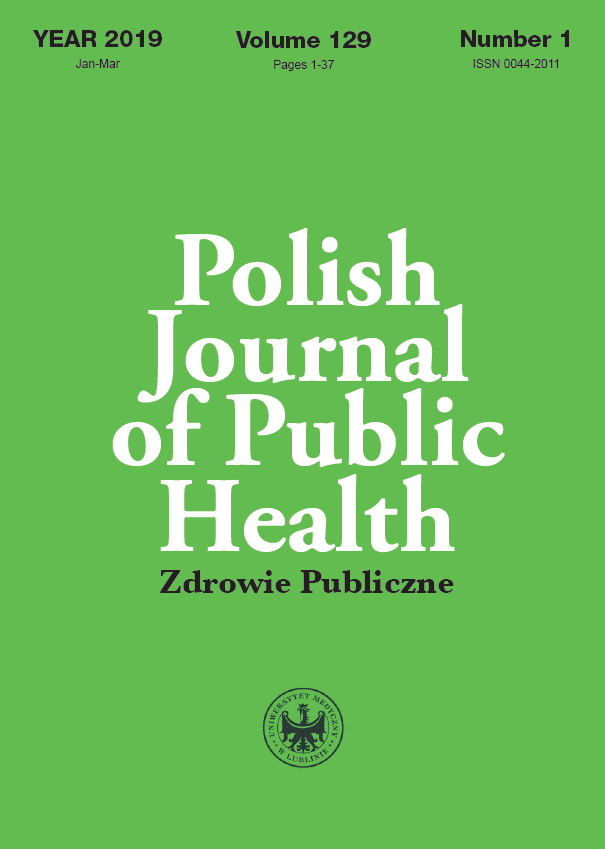Contemporary architecture and urban planning of urban multi-family housing, and the state of health of the society
DOI:
https://doi.org/10.2478/pjph-2019-0008Keywords:
architecture, urban planning, residents, healthAbstract
Introduction. For years, the influence of place of residence on human health has been the subject of interest of researchers from various scientific disciplines. The basic task in shaping space is to create conditions for proper mental and physical development, the experience of beauty, family life, social and individual life. Biotechnology, psychology and sociology, taking into account technical and aesthetic requirements, are the main design criteria for residential buildings.The omission of the most important assumptions in the design of multi-family housing might be very harmful for residents and can be expressed, for example, in poor mood, reduced work efficiency, depression, an increase in the incidence of diseases and even an increase in mortality. Deepening knowledge about proper living conditions is very important in the pro-health aspect.
Aim. An attempt to answer the question to what extent human development and life are subordinated to staying in specific rooms, dwellings, housing estate, district, and finally the city and the entire metropolitan foundation.
Material and methods. This study is for demonstrative purposes based on a review of publications on the quality of life of residents of urban multi-family housing in the aspect of urban planning and architecture.
Results. The correct insolation of residential premises, shapeof the block, the color and texture of the facade, the location and selection of greenery, lawns, paved surfaces and the layout of buildings are just some of the factors affecting the health of residents. Proper design, construction and operation reduce the presence of bacteria and mold fungi, which directly translates into microbiological health risks.
Conclusions. For the proper existence of city dwellers, it is necessary to maximize the use of sunlight and to educate in the proper use of rooms. Raising health conditions, through both proper insolation and the location of flats, “urban interiors”, areas between residential buildings, thoroughfares, playgrounds, sports fields, recreational and recreational areas, directly translates into human health.
References
1. Goniewicz M. Kształcenie ratowników medycznych w Polsce – przeszłość, teraźniejszość, przyszłość. In: M. Goniewicz, G. J. Nowicki (eds). Ratownictwo medyczne – teraźniejszość i przyszłość. Lublin: Perfecta; 2012. p. 147-65.
2. Matysiak A, Wyrozębska A. Historia zawodu ratownika medycznego. Med Dydak Wychow. 2011;7-8:24-7.
3. Wnukowski K, Kopański Z, Sianos G. Specyfika pracy ratownika medycznego. JCHC. 2015;3:2-9.
4. Goniewicz M. Kształcenie ratowników medycznych w Polsce – proponowane rozwiązania. Nauka i szkolnictwo wyższe. 2010;1-2(35-36):275-93.
5. Goniewicz M. Ratownik medyczny – kluczowy zawód systemu Państwowe Ratownictwo Medyczne. In: J. Konieczny (ed). Ratownictwo w Polsce lata 1990-2010. Poznań: Oficyna Wydawnicza Gramond; 2010 p. 145-55.
6. Rozporządzenie Ministra Zdrowia z dnia 29 grudnia 2006 r. w sprawie szczegółowego zakresu medycznych czynności ratunkowych, które mogą być podejmowane przez ratownika medycznego (Dz. U. 2007, Nr 4, poz. 33).
7. Rozporządzenie Ministra Zdrowia z dnia 14 stycznia 2009 roku zmieniającym rozporządzanie w sprawie szczegółowego zakresu medycznych czynności ratunkowych, które mogą być podejmowane przez ratownika medycznego (Dz. U. 2009, Nr 11, poz. 64).
8. Ustawa z dnia 8 września 2006r. o Państwowym Ratownictwie Medycznym (Dz. U. 2017, poz. 2195).
9. Ustawa z dnia 25 września 2015 r. o zmianie ustawy o Państwowym Ratownictwie Medycznym, ustawy o działalności leczniczej oraz ustawy o zmianie ustawy o działalności leczniczej oraz niektórych innych ustaw (Dz.U. 2015, poz. 1887).
10. Rozporządzenie Ministra Zdrowia z dnia 20 kwietnia 2016 r. w sprawie medycznych czynności ratunkowych i świadczeń zdrowotnych innych niż medyczne czynności ratunkowe, które mogą być udzielane przez ratownika medycznego samodzielnie bez nadzoru lekarza (Dz.U.2016, poz. 587).
11. Rozporządzenie Ministra Zdrowia z dnia 3 lipca 2017 r. zmieniające rozporządzenie w sprawie medycznych czynności ratunkowych i świadczeń zdrowotnych innych niż medyczne czynności ratunkowe, które mogą być udzielane przez ratownika medycznego (Dz.U. 2017, poz. 1364).
12. Rozporządzenie Ministra Zdrowia z dnia 2 października 2017 r. w sprawie doskonalenia zawodowego ratowników medycznych (Dz.U. 2017, poz. 1884).
Downloads
Published
Issue
Section
License
Copyright (c) 2019 Polish Journal of Public Health

This work is licensed under a Creative Commons Attribution-NonCommercial-NoDerivatives 3.0 Unported License.


